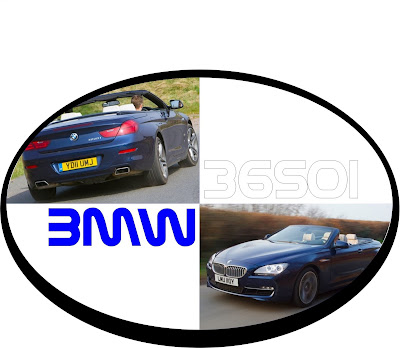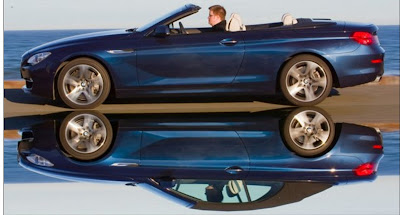Test date 30 March 2011 Price as tested £73,430

BACKGROUNG
BMW’s outgoing 6-series proved that conventionally appealing styling isn’t a prerequisite of success in a luxury grand tourer. With 14,000 examples sold in the UK since 2003, it accounted for an average of 25 per cent of registrations within its class, at times even outselling Jaguar’s seductive XK.
The arrival of the new 6-series completes a cycle of renewal for BMW stretching back three years. With the current 7-series, it released its first car based on a new platform called ‘L6’. Designed to underpin all of the car maker’s large rear-wheel-drive cars, the same platform has also spawned the 5-series Gran Turismo, the latest 5-series saloon/Touring and even the £200k Rolls-Royce Ghost.
So versatile is this platform that it can also serve under the subject of this week’s road test – the all-new 650i Convertible – as well as the 6-series coupé (which arrives in the UK this October) and the Merc-CLS-rivalling 6-series Gran Coupé four-door (which will be launched later still). So can you really take a platform first used for a full-size limo and adapt it to make a convincing open-top GT?
 DESIGN
DESIGNThe 6-series convertible has put on 39mm of width (now 1895mm) and 74mm of length (4897mm) in the transition from second to third generation. Its body-in-white is predominantly high-strength steel but has been reinforced in key areas with hot-formed ultra-high-tensile steel and is 50 per cent more torsionally rigid than the previous car’s.
Measures to bolster crash safety include a reinforced floor, sills and B-pillars, an ultra-high-strength windscreen frame and automatically deployed aluminium rollover bars that pop up from behind the rearmost head restraints in the event of a roll.
The doors, bonnet and front axle spring mounts are made of cast aluminium to reduce weight. Other measures include thermoplastic front wings and a tonneau cover and bootlid made of glassfibre composite. Even after those efforts, though, BMW quotes a kerb weight of 2015kg for this eight-cylinder 2+2 – 80kg more than the car it replaces. According to our scales, our test car weighed 2085kg with a full tank of fuel. That’s substantial indeed for a car of this type, but it’s not unprecedented. The Maserati GranCabrio we road tested in 2010 weighed just as much.
Just like its sister models, the 6-series is suspended via aluminium double wishbones up front and BMW’s Integral-V multi-link set-up at the rear. Steel springs, passive dampers and fixed-rate anti-roll bars come as standard, but if you pay extra for Adaptive Drive, the 6-series’ specification is upgraded with adaptive dampers and active anti-roll bars – just as our test car’s was. Four-wheel steer and an active, variable-ratio steering system come packaged as another option – Integral Active Steering – but that equipment was left off our test.
Even considering all of that advanced chassis technology, the headline attraction is still under the 650i’s bonnet: an all-aluminium 4.4-litre, direct-injection petrol V8, which drives the rear wheels via an eight-speed ZF automatic gearbox. One turbocharger per cylinder bank gives it 402bhp and a remarkable 442lb ft of torque all the way from 1750rpm to 4500rpm.
ONtheroad
Of all the performance figures we logged, only one seemed below par. BMW claims 5.0sec dead for this car’s sprint to 62mph, but our two-way average from zero to 60mph – 5.6sec – suggests that’s a bit optimistic.
But don’t think that this is anything other than a seriously rapid car. Lots of short intermediate gear ratios, a wide plateau of torque and a superbly fast-acting auto gearbox make the 650i simply hurtle into the middle distance when you want it to. You can reach 100mph in 12.4sec, only half a second slower than in the 552bhp Bentley Continental GTC we tested in 2006.
Even in Normal mode on the car’s multi-setting Drive Dynamic Controller and ‘D’ on the gearbox, the 650i’s turbos seem to respond instantly to wide throttle openings, and the car’s torque converter never slips. So you surge forwards on a swell of mid-range potency that’s refined and effortless but also venomous.
More amazing still is the flexibility of the 650i’s performance. Consider its fifth-gear acceleration. Put the gearbox into manual mode and the Drive Dynamic Controller into Sport and the car will hold on to an intermediate ratio, unless you flatten the throttle past its kickdown detent. Do that and, with the engine barely pulling 2000rpm, 30-50mph takes 3.5sec. So does 40-60mph, 50-70mph and every other 20mph increment up to 100mph, give or take a couple of tenths.
That kind of urge makes overtaking easy almost no matter which gear you’re in, and it allows you to travel every bit as quickly as the terrain permits. Better still if you’re a fan of laid-back ground-covering, there’s no ostentatious exhaust blare that comes along with that performance: a bassy, cultured V8 woofle, sure, but certainly not the kind of howl that announces itself from 200 yards or impinges upon cabin refinement at speed.
The more money you spend on your 650i, the longer it’ll take you to familiarise yourself with all of its active and adaptable chassis systems, its various driving modes and its many driver assistance gadgets. Which is fine, up to a point. Complexity goes hand in hand with sophisticated technology, after all. And sophisticated technology is what you want your £80k BMW drop-top to have. But if you’ve spent time fiddling with the various software control algorithms for the dampers, anti-roll bars, stability control systems and power steering and are no closer to having a car you’re completely satisfied with… well, then you’ve got a problem.
That’s the situation this BMW puts its driver in. With four chassis modes ranging from Comfort to Sport+, and three gearbox control maps, you’d imagine one combination would allow you to connect with the dynamic character of the car on a cross-country road, and to explore its handling potential. But whatever mode you select, the 650i seems to remain frustratingly aloof.
Normal and Comfort modes allow you plenty of compliance for comfortable town and trunk road mileage, but not enough steering precision or body control for more challenging roads. Sport mode makes the car’s dynamic demeanour more accurate and composed, enough for keen back-road driving with lots of grip and commendable roll control. But at times Sport sends an unsettling shudder through the car’s body structure over a sharp-edged bump.
None of the modes dials much natural feel into the electric power steering system, which seems sticky at times and overly heavy at others. None of them really counteracts a mild tendency towards understeer. But worse still, none of them feels like a proper baseline setting in which the 650i offers an ideal blend of control and compliance.
LivinG
One of the biggest disappointments of the previous 6-series was that it offered little or no additional practicality over a relatively humble 3-series coupé or convertible. The new car is more creditable in that regard. A good chunk of the 74mm growth spurt has gone into the wheelbase, so this new 6-series has a cabin that’s remarkably spacious by class standards, with two rear chairs big enough for occasional use even by average-sized adults, if you’re prepared to sacrifice a little of the generous legroom you get up front. The boot can accommodate as much as 350 litres of luggage with the roof up and its soft storage sleeve folded away.
When entering a convertible of the 6-series’ type, it’s normal to adjust the driver’s seat squab to the bottom of its vertical travel just to sit low enough. That’s because, with so much underfloor strengthening, big convertibles tend to have relatively high-set front seats. Not the 6-series. BMW credits “intelligent seat design” for a driving position that’s low, even for taller drivers, helping to keep you sheltered from the wind.
With an upper dashboard, intrument cowl and upper door cards swathed in soft leather, which swoops down elegantly to link up with the leather topping on the centre console, the 650i’s cabin is, for the most part, richly upholstered. It would have a more special ambience were it not for a few too many stock BMW parts bin components of the sort that you’d expect on a £30k 5-series, but not a £75k luxury tourer. As it is, the cabin feels luxurious and comfortable but doesn’t distinguish itself clearly enough from lesser models.
A car that returns only 28.9mpg on the motorway may sound thirsty to many, but by the standards of its V8 drop-top peers, many of which struggle to better 25mpg on the run, the 650i is frugal. Emitting 249g/km of CO2, this BMW is also £200 cheaper to tax every year than an equivalent Jaguar XK or Mercedes SL500.
Value seems to speak strongly for the car, too. Priced from £73,430, the 650i Convertible is cheaper than the entry-level Porsche 911 Cabriolet – undercut only by Jaguar’s 5.0-litre XK – and comes with 19in alloy wheels, Dakota leather upholstery and a 10.2in sat-nav system. Just beware the options list, because a fully loaded 650i with Adaptive Drive, Integral Active Steering, a head-up display and all of the other toys will cost you more than £94k
Verdict
A superbly accomplished car, unless you’re a driving enthusiast The 650i Convertible has a breadth of ability that’s unrivalled in its class. A remarkable powertrain, versatile chassis and practical body allow it to play almost any role with conviction: weekend hotrod, long-haul GT, occasional four-seater or carefree drop-top. Convertibles certainly don’t come much faster, better mannered or more thoroughly executed.
The role this 6-series struggles with is the one you may miss the most: for all its basic speed, it’s an uncommunicative driver’s car. Despite the army of active chassis systems, it’s essentially an inert, unresponsive car that lacks balance and poise, and feels heavy and cumbersome when really tested.
How much that will detract from your enjoyment depends on how keen a driver you are because, in other ways, the 650i is as uncompromised as convertibles get.
How much ?* Price as tested £73,430
* Price as tested £73,430How fast* 0-30mph no data
* 0-60mph no data
* 0-100mph no data
* 0-150mph no data
* 0-200mph no data
* 30-70mph no data
* 0-400m no data
* 0-1000m no data
* 30-50mph in 3rd/4th no data
* 40-60mph in 4th/5th no data / no data
* 50-70mph in 5th no data
* 60-0mph no data
* Top speed no data
* Noise at 70mph no dataHow thirsty?* Test average no data
* Test best/worst no data / no dataGovernment figures* Combined/urban 26.4 / 18.2 mpg
* CO2 emissions 249 g/kmHow big?* Length 4894 mm
* Width 1894 mm
* Height 1365 mm
* Wheelbase no data
* Weight 1940 kg
* Fuel tank 70.0 litresEngine* Layout V8 cyls 90 degree Vee , 4395 cc
* Max power 402 bhp at 5500 rpm
* Max torque 443 ft at 1750 rpm
* Specific output 91.5 bhp per litre
* Power to weight 207bhp per tonne bhp per tonne
* Installation F
* Bore/stoke 89.0x88.3 mm
* Compression ratio 10.0:1
* Valve gear 4 per cyl
* Ignition and fuel no data, UnleadedGearbox* Type 8-speed Automatic
* 1st no data
* 2nd no data
* 3rd no data
* 4th no data
* 5th no data
* 6th no data
* Final drive no dataSuspension* Front no data
* Rear no dataSteering* Type no data
* Lock to lock no dataBrakes* Front no data
* Rear no dataWheel & tyres* Size front no data
* Size rear no data
* Made of Alloy
* Tyres front no data
* Tyres rear no data







0 comments:
Post a Comment